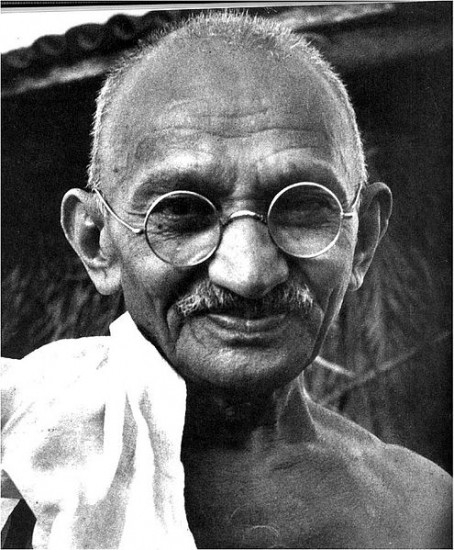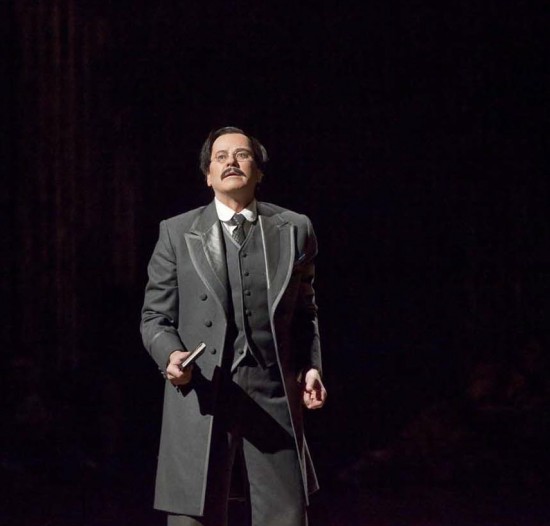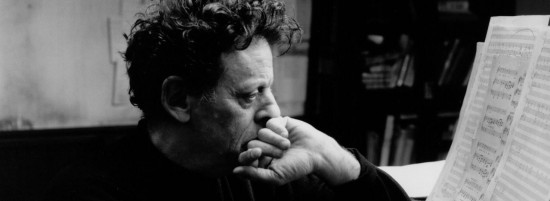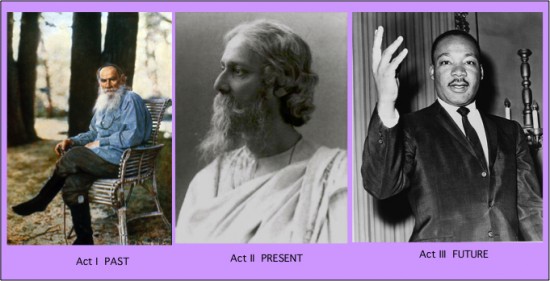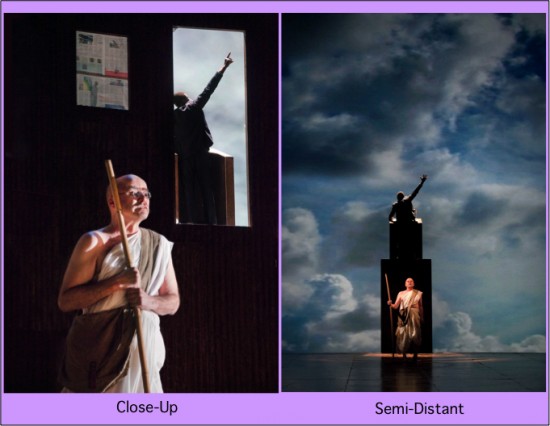I approached Satyagraha at 10:00 A.M. this morning, Saturday November 19, 2011 with great anticipation – and the performance I witnessed exceeded my highest expectations. But how can I possibly convey in words what I felt as I sat through this opera by one of the world’s top-rated living composers performed by the world’s top-rated opera company with an outstanding cast and chorus and presented in state-of-the-art High Definition, satellite transmitted to especially equipped movie theatres throughout the world?
My first acquaintance with Philip Glass was seeing his Koyaanisqatsi: Life Out of Balance for chorus, ensemble and orchestra (1982) on PBS. The combination of sound and picture was extremely dramatic whereas either one alone would have left me cold.
I had the same reaction when I attended the world premiere of Life: A Journey Through Time, a multi-media slide show of pictures by National Geographic photographer Frans Lanting choreographed by Alexander V. Nichols with music by Philip Glass, arranged for orchestra by Michael Riesman, on July 29, 2006 at the Cabrillo Festival of Contemporary Music in Santa Cruz, California (USA) by the Cabrillo Festival Orchestra conducted by Marin Alsop. Outside the door I could have purchased a cocktail table book of Lantings photographs or an audio CD of Glass’ score – I wasn’t a bit tempted by either, but I went back to the encore performance the next night.
When I was in college in the early 1940’s, the name of Mahatma Gandhi was regarded with reverence and awe. Those of us who were struggling with the moral consequences of war and the military draft took great inspiration from his non-violent direct action resistance movement in India. Although his ideas were spreading world wide, it never occurred to me that the man himself was associated with any country other than India. Only today did I find out that he was already 45 years old when he did his first work in India, and that for the preceding 21 years he had been formulating, developing, and practicing them in South Africa.
In Satyagraha, Glass, his librettist Constance DeJong, and the entire creative staff* of the MetHD production have presented the essence of Gandhi’s 21 years in South Africa in a most unusual fashion – the complete opposite of verismo. We do not see an acted-out sequence of events (as in Boris Godunov or Nixon in China for example) but rather an attempt to visualize the effect that these events had on the development of Mahatma Ghandi.
The word “Satyagraha” is Sanskrit and means literally “the insistence of truth”. The entire opera, in fact, is sung in Sanskrit (a challenge for the singers!). The subtitles are not literal translations of the words being sung (which involve endless repetition), but are translations of relevant quotations from the Bhagavad GÄ«tÄ, a 700-verse Hindu scripture. In an interview, Philip Glass explained that when the GÄ«tÄ was created hardly anyone could read so that Sanskrit was a spoken language – meaning was conveyed from mouth to ear, rather than from hand to eye. Thus he believed that the audience would come closer to involvement with Ghandi’s thoughts and feelings if we relied on our ears and on the stage action and were not distracted by written English words. On the whole, I would say it worked.
With virtually no exceptions, the opera takes place in extreme slow motion. The combination of the repetitive music and slow measured steps was, at times, almost mesmerizing. The total effect was disquieting. I found it fascinating, but Sara was so disturbed that she left halfway through Act II. De gustibus non disputandem.
I won’t attempt to give any kind of synopsis – the Met website contains a 1000+ word summary, so there’s no point my duplicating it. But I do want to mention a couple of specifics that caught my attention.
First, the music. I make an honest effort to open my mind and to enjoy modern music whenever I encounter it in opera. I must admit that I do not always succeed. Philip Glass’ music is certainly “modern” – the intermission featured a live interview with him. At first listen, you think “strange”. But if you listen closely, the strangeness is in his use of repetition. However, if you concentrate on just a single cycle, it is really quite pleasant. It is melodic, any dissonances in the harmonics are resolved, and it is obsessively rhythmic.

Miss Schlesen, obscured (Rachelle Durkin), Kasturbai (Maria Zifchak), Mrs. Naidoo, partially obscured (Molly Fillmore), Ghandi (Richard Croft), Parsi Rustomji (Alfred Walker), Mr. Kallenbach (Kim Josephson) in Act III
I was particularly aware of the music at the beginning of Act III. As the curtain rises the orchestra is playing and the group of principals and chorus on stage are all silent. The orchestra repeats their beautifully harmonic opening phrase over and over and over – always quiet and subdued. After a bit, Kasturbai (Mezzo Maria Zifchak) sings the simple melody along with them, also piano. Later, Mrs. Naidoo (soprano Molly Fillmore) joins them and the two women sing in exquisite close harmony. Repetitive, but anything but boring.
Each of the three acts has the name of a person whose actions bore a close connection to Ghandi: Leo Tolstoy representing the past, the great Indian poet Rabindranath Tagore for the present, and Martin Luther King, Jr. the future. Early in their act, a member of the chorus rises and two other chorus members dress and wig him appropriately. In Acts I and II this takes place on a balcony and the character just sits there as part of the scenery.

Act III - Foreground: Mr. Kallenbach (Kim Josephson), Parsi Rustomji, partially obscured (Alfred Walker), Mrs. Naidoo (Molly Fillmore), Ghandi (Richard Croft), Miss Schlesen (Rachelle Durkin), Kasturbai (Maria Zifchak); Background center: unnamed actor depicting Martin Luther King Jr.
King’s vestiture takes place at stage-level after which he mounts a flight of steps to a pulpit, all with his back to the audience. For the rest of the Act we see his back-lighted silhouette with his arms gesticulating as if he were delivering his famous I Had a Dream oration to an audience behind the back of the stage. During the latter part of the act all of the backdrop is stripped away leaving only the pulpit and King preaching mutely to infinity.
It occurred to me during the second intermission that the four thousand or so people seeing this opera live in Lincoln Center were having a quite different experience than were the uncounted thousands watching it in movie theatres all over the world. I didn’t envy them. During intermissions we were in on fascinating interviews with, among others, composer Philip Glass, Chorus Master Donald Palumbo, and a couple of members of the Skills ensemble. This latter was a elite group of “stage hands” with specialties such as acrobatics and puppetry. All of these interviews helped us gain great insight into the inner meaning of the opera.
The most important advantage we had over the live audience was the help of TV Director Barbara Willis Sweete. As I mentioned before, all of the stage motion is slow, the music is repetitive, the language is Sanskrit, and the English subtitles are sparse. It must take incredible concentration from the live audience to maintain interest in this semi-stasis. Sweetes cameras helped that concentration tremendously. A camera would slowly pan across the stage giving us slow-moving closeups of the individual chorus members. We had a chance to see their expressions and postures and to note fine points of their costumes.
Other times the camera would slowly pan in and out from full-stage views to larger-than-life facial expressions, encouraging us on the one hand to think about Ghandi’s relationship with all humanity, and on the other to note the way his face conveyed his total concentration as he searched for the meaning behind the words he was singing – searched for Satyagraha.
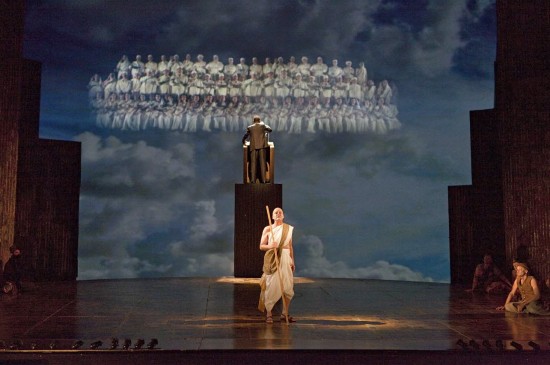
Finale to Act III - Martin Luther King (unnamed actor) was inspired by the life of Ghandi (Richard Croft)
The encore will be on Wednesday December 7 at 6:30 P.M. local time. I hope to see it again then. Should you go? I say, give it a try. It’s not expensive as operas go. Since the theatre is dark you don’t even have to wait for intermission to walk out if you don’t like it. My only advice is that your liking or disliking of other modern operas may not a good indicator of how you’ll feel about Satyagraha.
The Opera Nut
* CREATIVE STAFF
Production…………
Associate Director….
Set Designer……….
Costume Designer……
Lighting Designer…..
Video Design……….
TV Director………..
Phelim McDermott
Julian Crouch
Julian Crouch
Kevin Pollard
Paule Constable
Leo Warner, Mark Grimmer for 59 Productions
Barbara Willis Sweete
Photos, except as noted: Ken Howard/Metropolitan Opera
This review by Philip G Hodge appeared in sanfranciscosplash.com on November 23, 2011.



